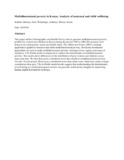| dc.contributor.author | Kabubo-Mariara, Jane | |
| dc.contributor.author | Wambugu, Anthony | |
| dc.contributor.author | Musau, Susan | |
| dc.date.accessioned | 2013-07-17T06:05:52Z | |
| dc.date.available | 2013-07-17T06:05:52Z | |
| dc.date.issued | 2010-04 | |
| dc.identifier.citation | Kabubo-Mariara J, Wambugu A, Musau S, Multidimensional poverty in Kenya: Analysis of maternal and child wellbeing, 2010 | en |
| dc.identifier.uri | http://www.pep-net.org/fileadmin/medias/pdf/files_events/8th-PEPmeeting2010-Dakar/papers/Anthony_Wambugu.pdf | |
| dc.identifier.uri | http://erepository.uonbi.ac.ke:8080/xmlui/handle/123456789/48208 | |
| dc.description.abstract | This paper utilizes Demographic and Health Survey data to generate multidimensional poverty profiles for women and children in Kenya during the period 1993 to 2003.We measure well being in two dimensions: assets and health status. The Alkire and Foster (2007) counting approach is applied to measure and order multidimensional poverty. Stochastic dominance approaches are used to make multidimensional poverty orderings across regions and areas of residence. A bi-Probit model is employed to explore the determinants of multidimensional poverty. The results show differences in the distribution of poor women and children across space and time. We find that assets contributed more than health to multidimensional poverty over the 10 year period.
Rural areas contributed more than urban areas, while boys made a larger contribution than girls.
The bi-Probit model results suggest that understanding the determinants of well being in a multidimensional context can generate useful policy insights for improving human capital investments in Kenya. | en |
| dc.language.iso | en | en |
| dc.publisher | University of Nairobi | en |
| dc.title | Multidimensional poverty in Kenya: Analysis of maternal and child wellbeing | en |
| dc.type | Article | en |
| local.publisher | School of Economics | en |


